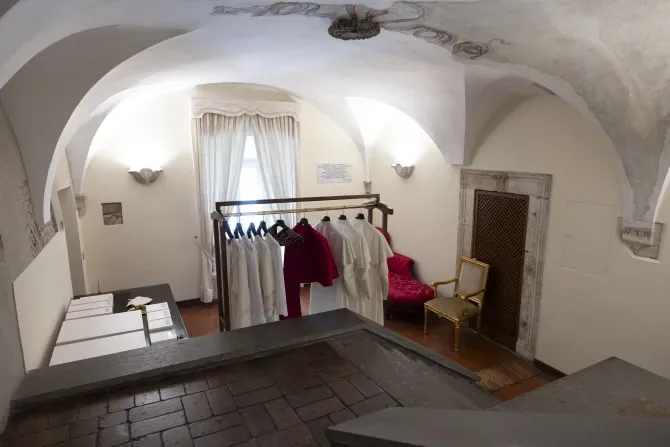The Vatican is a city steeped in rich history, profound spirituality, and intricate rituals. Among its many sacred halls and chambers, the Room of Tears stands out as a significant location for newly elected popes. Each pope, upon being elected, undergoes a unique and emotional experience in this hallowed space, and this article will delve into its importance, the symbolism contained within, and its role in the broader context of the papacy.
The Room of Tears is located just off the Sistine Chapel, the setting for the conclave where cardinals gather to elect a new pope. It’s here that cardinals historically have made the life-altering decision of who will lead the Catholic Church. Following this monumental event, the elected pope is led into the Room of Tears, named for the tears of joy and sorrow that new leaders may shed as they recognize the gravity of their responsibilities.
The Conclave: A Prelude to the Room of Tears
Before discussing the Room of Tears itself, it is essential to understand the significance of the conclave. The conclave process has evolved significantly over the centuries. The current structure dates back to the Papal Bull of 1059, which aimed to minimize outside influences on the election process. Today, the approximately 120 cardinal electors, who are under 80, convene in the Sistine Chapel to select the new pope through secret ballots. It can take several rounds of voting, often lasting days, before a consensus is reached.
Once a cardinal receives a two-thirds majority of votes, he is elected. He is then asked if he accepts the position, to which the answer is typically a solemn affirmation. After this momentous decision, the newly elected pope is led to the Room of Tears.
The Significance of the Room of Tears
The Room of Tears is often described as a transitional space, a brief pause between the weight of an individual’s old life and the new divine calling of the papacy. Inside this modestly sized room, adorned with simple furnishings, the pope can take a moment to reflect on the gravity of the responsibilities he has just accepted. The interior features an altar and a few items designated for personal reflection.
Cardinals may have entered the conclave with dreams of the papacy, but the reality hits immediately upon election. The papacy is not just a position of prestige; it entails a commitment to lead the world’s largest Christian denomination, address global issues like poverty and injustice, and offer spiritual guidance to millions. This realization often sparks an emotional response, leading many new popes to shed tears.
The Emotional Weight of Leadership
The tears shed in this room can be interpreted in several ways. They may be tears of joy, expressing gratitude for being chosen to serve God and the Church. Conversely, they can also represent sorrow, reflecting on the immense burdens and challenges that lie ahead. The initial reaction is often one of disbelief and humility, as the pope contemplates the legacy of previous pontiffs and the expectations from both the Vatican and the global church.
Moreover, this moment in the Room of Tears can serve as a personal prayer, where the elected pope may seek divine guidance and strength for their impending responsibilities. It is a moment of solitude amid one of the most public transitions in the world, where one can commune with God before stepping into the spotlight.
Historical Perspectives: Popes and Their Experiences
Every pope has had a unique experience in the Room of Tears, shaped by their personality, background, and the specific circumstances surrounding their election. For instance, Pope Francis, upon his election in 2013, reportedly took a moment in solitude, praying for the strength to fulfill his mission of humility, compassion, and reform within the church. His election marked a pivotal moment in Vatican history, igniting a series of controversial yet transformative changes.
In contrast, Pope Benedict XVI, who served from 2005 to 2013, expressed deep humility and a sense of unexpected calling during his time in the Room of Tears. He entered the papacy following the tumultuous tenure of Pope John Paul II and faced significant challenges, including theological dissent and critiques of the Church’s handling of sexual abuse scandals. His emotional response reflected the historical weight he felt, signifying that every pope’s experience is both personal and collective.
Traditions and Rituals
Beyond the emotional interactions that take place within these walls, the Room of Tears also symbolizes the deep-rooted traditions of the Catholic Church. It serves as a reminder of the historical and theological weight of the papacy. From relics to artwork that reference biblical figures, the design elements in the room echo the Church’s commitment to faith and service.
After their moment in the Room of Tears, the new pope is dressed in papal vestments and prepares to make his first public appearance on the balcony of St. Peter’s Basilica, marking the official beginning of his papacy. The contrast between the intimate, reflective setting of the Room of Tears and the majestic vista of Saint Peter’s Square highlights the duality of a pope’s life—intimate prayer and immense public scrutiny.
Visiting the Room of Tears
While the Room of Tears is not generally accessible to the public, its legacy and stories have captured the imaginations of many Catholics and tourists alike. The experience within these walls has become a part of the rich tapestry of the Vatican, often discussed and elaborated upon in documentaries and literature about the papacy. Visitors to the Vatican often express a desire to understand more about the rites of passage that new popes endure, and the Room of Tears remains an iconic symbol of that journey.
Conclusion: Embracing a Sacred Legacy
The Room of Tears serves not just as a physical space but as an emblematic threshold for newly elected popes, marking the start of their transformative journey. It is a poignant reminder of the complexity of spiritual leadership and the emotional weight that accompanies serving one of the largest faith communities in existence. As the Church faces modern challenges, the sentiments shared in the Room of Tears continue to resonate, highlighting the Pope’s role as both a spiritual guide and a human being navigating the trials and triumphs of faith.
Ultimately, the Room of Tears invites reflection on the nature of leadership itself, the fusion of human emotion with divine calling. It stands as both a reminder of the burden and blessing of papal authority, encapsulating the faith journey of leaders meant to inspire hope, compassion, and service within a challenging world.







